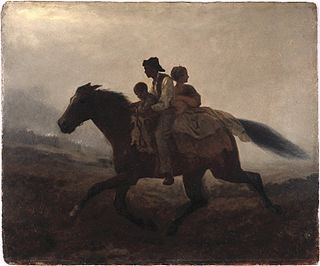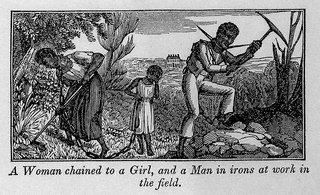
"Bury Me in a Free Land" is a poem by African-American writer and abolitionist Frances Harper, written for The Anti-Slavery Bugle newspaper in 1858. [1]

"Bury Me in a Free Land" is a poem by African-American writer and abolitionist Frances Harper, written for The Anti-Slavery Bugle newspaper in 1858. [1]
The poem implies that the speaker is dying soon, which lends her request a sense of urgency. The message being presented as a sort of deathbed wish also gives the request stronger moral authority. [2] The use of grave imagery to draw sympathy to the plight of enslaved people was popularized with Harriet Beecher Stowe's popular novel Uncle Tom's Cabin (1852), whose titular character is buried in an unmarked grave. [3] Harper's poem seems to threaten that the narrator will haunt those who survive as she "could not rest" if she was buried in a land where people are enslaved. [4]
Harper sent a copy of the poem to the widow of John Brown after his execution for his raid on Harpers Ferry. [5] She also republished the poem after emancipation in the United States in the January 14, 1864, issue of The Liberator . [6]
This poem was recited in the film August 28: A Day in the Life of a People, which debuted at the opening of the Smithsonian's National Museum of African American History and Culture in 2016. [7] [8] [9]
An excerpt from the poem is on a wall of the Contemplative Court, a space for reflection in the Smithsonian's National Museum of African American History and Culture. The excerpt reads: "I ask no monument, proud and high to arrest the gaze of the passers-by; all that my yearning spirit craves is bury me not in a land of slaves." [8]

Frederick Douglass was an American social reformer, abolitionist, orator, writer, and statesman. After escaping from slavery in Maryland, he became a national leader of the abolitionist movement in Massachusetts and New York, during which he gained fame for his oratory and incisive antislavery writings. Accordingly, he was described by abolitionists in his time as a living counterexample to enslavers' arguments that enslaved people lacked the intellectual capacity to function as independent American citizens. Northerners at the time found it hard to believe that such a great orator had once been enslaved. It was in response to this disbelief that Douglass wrote his first autobiography.

Sojourner Truth was an American abolitionist and activist for African-American civil rights, women's rights, and alcohol temperance. Truth was born into slavery in Swartekill, New York, but escaped with her infant daughter to freedom in 1826. After going to court to recover her son in 1828, she became the first black woman to win such a case against a white man.

The Underground Railroad was a network of secret routes and safe houses established in the United States during the early to mid-19th century. It was used by enslaved African Americans primarily to escape into free states and from there to Canada. The network, primarily the work of free African Americans, was assisted by abolitionists and others sympathetic to the cause of the escapees. The slaves who risked capture and those who aided them are also collectively referred to as the passengers and conductors of the "Underground Railroad". Various other routes led to Mexico, where slavery had been abolished, and to islands in the Caribbean that were not part of the slave trade. An earlier escape route running south toward Florida, then a Spanish possession, existed from the late 17th century until approximately 1790. However, the network now generally known as the Underground Railroad began in the late 18th century. It ran north and grew steadily until the Emancipation Proclamation was signed by President Abraham Lincoln. One estimate suggests that, by 1850, approximately 100,000 slaves had escaped to freedom via the network.

Abolitionism, or the abolitionist movement, is the movement to end slavery and liberate enslaved people around the world.
David Walker was an American abolitionist, writer, and anti-slavery activist. Though his father was enslaved, his mother was free; therefore, he was free as well. In 1829, while living in Boston, Massachusetts, with the assistance of the African Grand Lodge, he published An Appeal to the Colored Citizens of the World, a call for black unity and a fight against slavery.

The Fugitive Slave Act or Fugitive Slave Law was a law passed by the 31st United States Congress on September 18, 1850, as part of the Compromise of 1850 between Southern interests in slavery and Northern Free-Soilers.

Frances Ellen Watkins Harper was an American abolitionist, suffragist, poet, temperance activist, teacher, public speaker, and writer. Beginning in 1845, she was one of the first African-American women to be published in the United States.

Slavery in Canada includes historical practices of enslavement practiced by both the First Nations during the pre-Columbian era, and by colonists during the period of European colonization.

In the United States, fugitive slaves or runaway slaves were terms used in the 18th and 19th centuries to describe people who fled slavery. The term also refers to the federal Fugitive Slave Acts of 1793 and 1850. Such people are also called freedom seekers to avoid implying that the enslaved person had committed a crime and that the slaveholder was the injured party.

African American history started with the arrival Africans to North America in the 16th and 17th centuries. Former Spanish slaves who had been freed by Francis Drake arrived aboard the Golden Hind at New Albion in California in 1579. The European colonization of the Americas, and the resulting transatlantic slave trade, led to a large-scale transportation of enslaved Africans across the Atlantic; of the roughly 10–12 million Africans who were sold by the Barbary slave trade, either to European slavery or to servitude in the Americas, approximately 388,000 landed in North America. After arriving in various European colonies in North America, the enslaved Africans were sold to white colonists, primarily to work on cash crop plantations. A group of enslaved Africans arrived in the English colony of Virginia in 1619, marking the beginning of slavery in the colonial history of the United States; by 1776, roughly 20% of the British North American population was of African descent, both free and enslaved.

Nat Turner's Rebellion, historically known as the Southampton Insurrection, was a rebellion of enslaved Virginians that took place in Southampton County, Virginia, in August 1831. Led by Nat Turner, the rebels killed between 55 and 65 White people, making it the deadliest slave revolt in U.S. history. The rebellion was effectively suppressed within a few days, at Belmont Plantation on the morning of August 23, but Turner survived in hiding for more than 30 days afterward.

The importation of enslaved Africans to what became New York began as part of the Dutch slave trade. The Dutch West India Company imported eleven African slaves to New Amsterdam in 1626, with the first slave auction held in New Amsterdam in 1655. With the second-highest proportion of any city in the colonies, more than 42% of New York City households held slaves by 1703, often as domestic servants and laborers. Others worked as artisans or in shipping and various trades in the city. Slaves were also used in farming on Long Island and in the Hudson Valley, as well as the Mohawk Valley region.

Slavery in Virginia began with the capture and enslavement of Native Americans during the early days of the English Colony of Virginia and through the late eighteenth century. They primarily worked in tobacco fields. Africans were first brought to colonial Virginia in 1619, when 20 Africans from present-day Angola arrived in Virginia aboard the ship The White Lion.
The Anti-Slavery Bugle was an abolitionist newspaper published in Ohio from June 20, 1845, to May 4, 1861. The paper's motto was "No Union with Slaveholders".

In the United States, abolitionism, the movement that sought to end slavery in the country, was active from the late colonial era until the American Civil War, the end of which brought about the abolition of American slavery for non-criminals through the Thirteenth Amendment to the United States Constitution.

This article documents the history of African-Americans or Black Philadelphians in the city of Philadelphia, Pennsylvania.
Poems on Miscellaneous Subjects is a poetry collection written by Frances Ellen Watkins Harper in 1854. Her non-fiction collection of poems and essays consists of a brief preface followed by a collection of poems and three short writings. Poems on Miscellaneous Subjects sold approximately 12,000 copies in its first four years in print and was reprinted at least twenty times during Harper's lifetime. The work includes several poetic responses to Harriet Beecher Stowe's Uncle Tom's Cabin. Harper’s work focuses on the themes Christianity, slavery, and women.
The Aliened American was a newspaper in Cleveland. It was the city's first black newspaper and is believed to have been the third newspaper for African Americans in the United States. Its first edition was published on April 9, 1853. William H. Day was the editor-in-residence and was assisted by Samuel Ringgold Ward, a former slave living in Toronto, and Rev. James W. C. Pennington of New York. Day moved to Buxton, Ontario, in 1855. It was printed on a monthly basis for one more year as the People's Exposition.